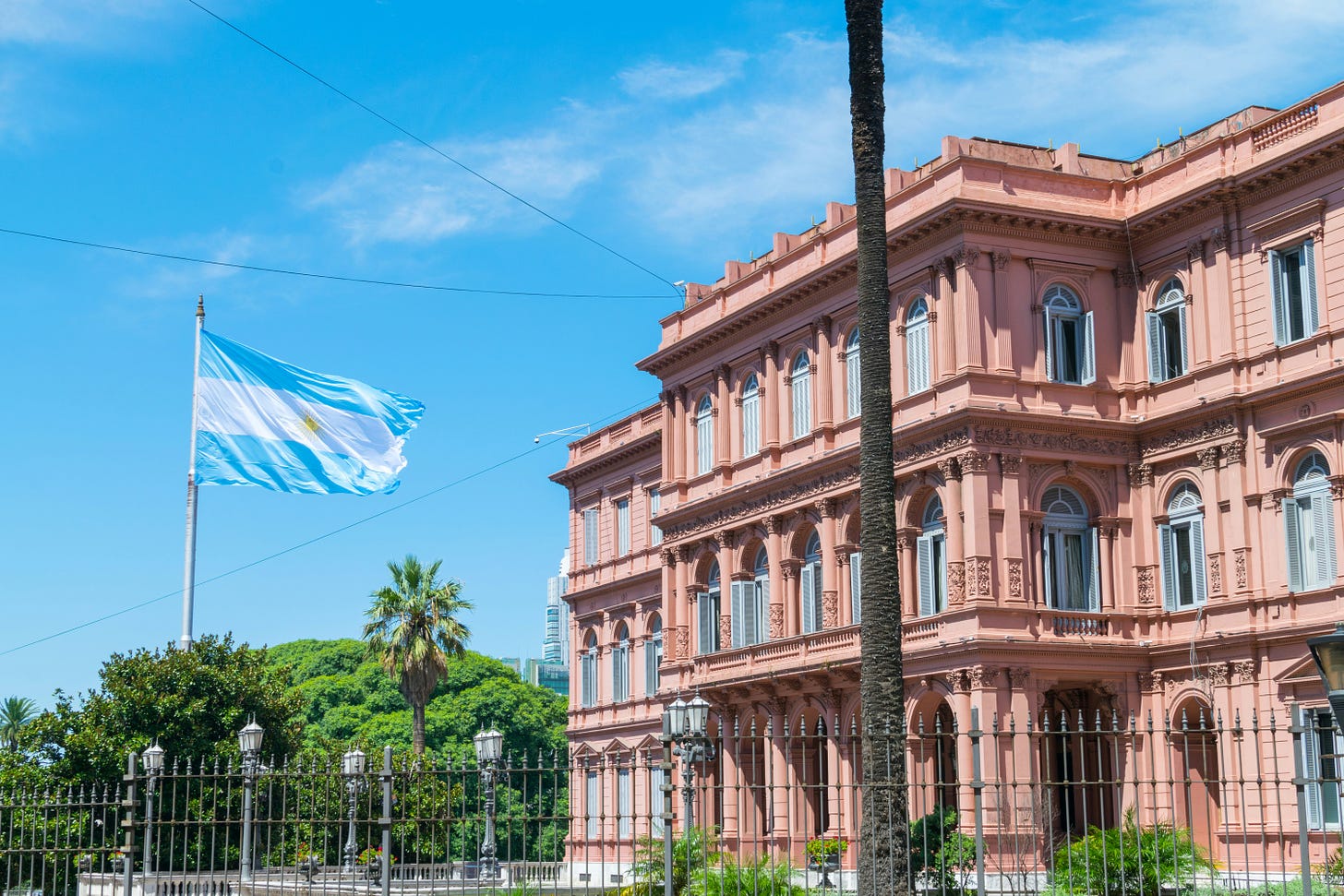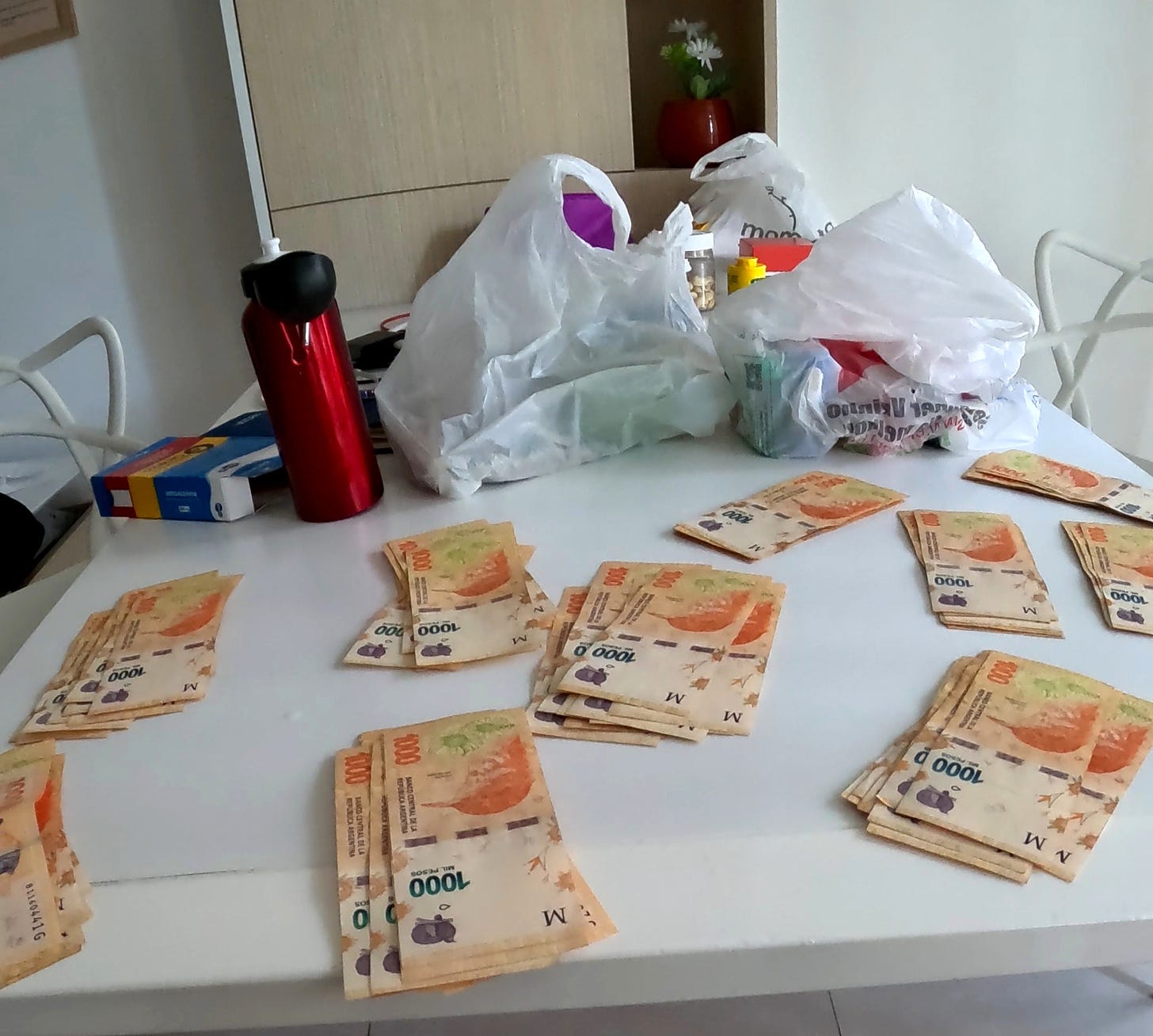
This piece is part of my Patagonia Diaries series about repeating a 16,000km roadtrip my parents did with me as a one year-old, where I share my reflections about myself and what I saw throughout the trip, covering a wide range of topics.
This post in particular needs a disclaimer. Feel free to skip it for now, but if something I wrote annoys you, just make sure to look at the footnote.
“I’m downstairs, can I come up?”, said the message.
I replied affirmatively and made my way to the door.
A minute later the elevator doors opened and a blonde woman in her mid-forties came out. She was quite friendly.
She was happy to stand outside the apartment but I insisted she come in and sit by the table. I couldn’t count that much money standing up.
As we sat down, I pulled out two large stacks of cash and began counting in front of her.
10, 20, 30… 170.
Seventeen stacks of ten bills each. One hundred and seventy thousand pesos.
She took the cash, thanked me, and left.
As I closed the door, I couldn’t help but feel like a gangster.
You see, Argentina is going through some rough times.
Inflation is through the roof (over 200% in 2023) and the currency has devalued significantly in the last few years.
As a result, dealing with money is a complicated thing.
There is an endless number of exchange rates, and navigating through them can be tricky.
I won’t go into too much detail here as this is not meant to be an explanatory post, so forgive me for any lack of precision.
But most importantly, there are three key rates: the blue rate, the white rate, and the Central Bank rate.
The Central Bank rate has for the longest time been kept extremely low artificially, and soon before we went on our trip one dollar equated to something like 350 or so pesos in this rate.
The white rate, or “official” rate, is what the Argentine peso trades at internationally. This hovered around 800 pesos throughout most of our time in Argentina.
You can already see a big difference — 350 pesos to 800. However, since the new president, Milei, took over, the Central Bank rate is now very close to the white rate.
And then, finally, you have the blue rate, which is the parallel market rate. Effectively what the dollar trades for “in the streets”, kinda.
When we arrived in Argentina the blue rate was 1100 pesos. Yet that doesn’t mean you’ll get exactly that if you go to an exchange house (legal or illegal). What you get will vary greatly, and can even be influenced by what bills you’re planning on exchanging. Hundred dollar bills will get you the best rate, and lower denominations will give you lower rates.
To give you have an idea, within the first 2 days in Argentina, I dealt with over five different rates. A restaurant actually offered me the proper blue rate (1100) to pay for the bill, whereas one cueva (informal exchange house) offered me 1050 and another 1070. The kiosk where I bought a SIM card from had it at 1060, and Uber, who did the currency conversion themselves rather than leaving it up to my credit card, did it at 1000.
See how it gets confusing?
On a side note, cuevas are an interesting experience in themselves. The first one we went to was a recommendation from some people at a cafe and it was an unmarked storefront that was shady-ish, whereas the second had exchange written in big letters outside, even though I’m still not sure it was entirely legal.
The funniest experience I had in a cueva though was in one that a lady from the laundry place suggested. It pretended to be a travel agency, with all sorts of pictures of trips on the wall and pamphlets advertising tours on the table next to the couch. While I was there, a soldier walked in and I tensed up, only to realize he was there to exchange money himself.
Anyway, so things get tricky and doing research can save you a fair bit. A lot of cards will convert at the official (white) rate for example, which can mean you’re taking a hit of over 20% compared to exchanging cash or using some other services like Western Union to get pesos (but I won’t get into that here).
Another thing that adds to the complexity is that while I was there, the largest denomination of a bill available was 2000 pesos, and those were hard to come by as they were new. While 20,000 and 50,000 peso bills are on the way, the vast majority of the time I was dealing with 1000-peso bills, which was annoying to carry around and pay for things with.
Thus, back to the apartment. Why was I going through all this trouble counting up money to pay for the place in cash?
Well, we booked it on Booking.com with a set price in dollars, but on arrival were told we could pay in cash in both dollars and pesos. However, for reasons I still don’t fully comprehend, she offered me the white rate if I paid in cash with pesos.
When selling dollars, the white rate for me is bad, as it means for my one dollar I’ll get fewer pesos. However, in this case I was effectively buying dollars, and she was offering a fantastic rate.
If this is confusing, let me put it in simpler terms. Let’s use round numbers and imagine the price we agreed on for the stay (through Booking.com) was 200$. I thus came with 200$ in my pocket but was told I could pay the equivalent in pesos at the white rate, which would mean 160,000 pesos.
So rather than giving her my supposedly equivalent 200$, I go to the cueva two blocks down and exchange my 200$ at a near-blue rate (say 1070) and get 214,000 pesos back. I then pay her the 160,000 and still have 54,000 left. (Which, by the way, were I to sell, I’d get a rate of maybe 1030 for, meaning I’d still have 52 or so dollars left.)
And thus, you can only begin to imagine how complicated day-to-day can get for regular Argentinians. You might think they don’t need to deal with all this dollar rate BS if they don’t want to, but in reality they kind of do. In some places businesses are almost forced to accept dollars and both for businesses and individuals ensuring you have dollars is essential for retaining wealth in a country where the currency is worth less and less each day.
It also didn’t just stop there. January saw a 20% inflation rate, meaning from the day we crossed the border from Uruguay to Argentina to the day we crossed the border back to Brazil, about a month later, prices were about 20% higher. Not only that, while we were there, the blue exchange rate spiked all the way to 1200 and then back to 1100, with the parallel market keeping up-to-date with it daily. Just a few days apart, a hotel exchanged money for us for 1200 while a cueva quoted me 1050, aiming to take advantage of those not keeping up with the rate having gone up from 1100.
That’s the brief summary of the money situation. Overall, it’s very complicated, and if you’re looking to visit Argentina soon, it’s worth spending some time researching about it.
But there was another thing I was curious about: how’s life for Argentinians?
In Brazil, there is a frequent rhetoric about “we don’t want to become like Argentina” or “this politician will turn us into Argentina”. So I was left wondering: how bad is it over there really?
And the answer is: I’m still not sure. But I was actually impressed, positively.
We drove all over the country, and stopped in a ton of cities and small towns in the North, South, East, and West. We were mostly left with the impression that it wouldn’t be so bad to turn into Argentina after all.
As I say this, I need to mention that this of course a subjective experience, that is in no way representative of what daily life is for Argentinians.
But while we somehow expected things to feel decadent in some way, they felt the opposite of that. Infrastructure was great – we encountered mostly good roads and almost always had access to great gas stations. I felt safer in most places than I do anywhere in Brazil. Even the tiniest countryside towns were clean and well-kept. We also saw very few people in precarious conditions, such as homeless or living in bad housing conditions.
And while a valid argument here could be that we just didn’t go to places where that is more prevalent, we toured most of the country and didn’t see a fraction of the things we openly saw during the time we spent in both Brazil and Chile during the trip (which combined was less than Argentina). We saw (keyword) a lot of extreme poverty in both Chile and Brazil that we did not see in Argentina.
Speaking to locals, the main sense I got is that while a lot of people might not necessarily be living in conditions that are supposedly as bad as in other places, the vast majority of people are struggling and working hard just to stay afloat. There’s also no expectation of a future — the goal is to get by today.
Thus I’m left with more questions than answers. Where’s the poverty? What does poverty actually look like in Argentina?
I wish I’d had more time to explore these questions in-depth, but for now, they’ll have to go on the back burner.
But there’s one more thing.
Brazilians and Argentinians have for long been considered rivals. This is mostly true on the football field, but it also extends beyond that sometimes.
However, I must say I had an incredible time in Argentina. The country is absolutely stunning, and the people are also fantastic. People were extremely open and friendly, and reminded me a lot of home. Asking for directions in the street, filling up the tank, ordering food, climbing at the gym, hiking, checking in at the hotel, people were always very nice and welcoming.
So if you have a chance, definitely head over to Argentina. I guarantee you’ll have a great time.
And Argentinians, thank you and best of luck. Just please let’s do better lunches than milanesa con papas next time, deal?










